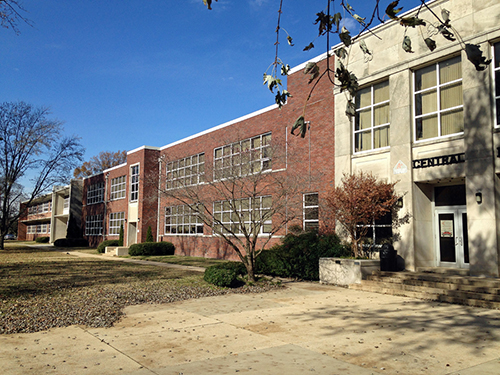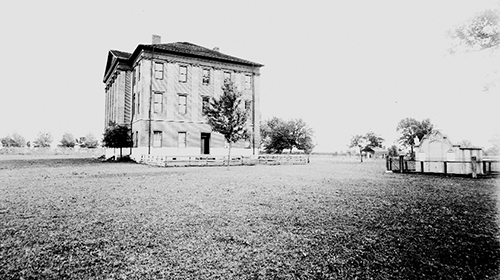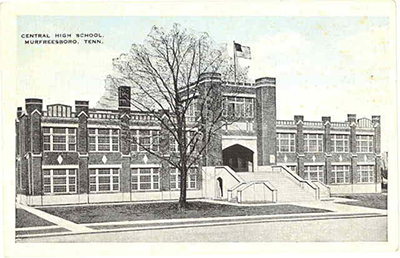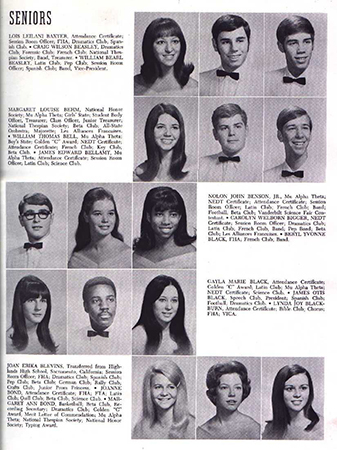MTSU students are seeking assistance from Murfreesboro and Rutherford County residents in preserving the history of what is now Central Magnet School.

Central Magnet School is shown from the front lawn looking northwest in a 2014 photo provided by Ethan Morris.
“This is really a community project, and so we want as much of their support and activity as we can get,” said Casey Gymrek, a master’s degree candidate from Cape Coral, Florida, and student in Dr. Brenden Martin’s “Essentials of Museum Management” class.
An interpretive exhibit will be placed in the magnet school’s “College Corner” in the western side of the building. MTSU students also will create a website where audio, video and still images will be posted.

Dr. Brenden Martin
Martin, an MTSU professor of history, is guiding the students as they interview teachers and alumni, seek donations of artifacts and peruse documents and photos from the campus’s nearly 175-year history.
“We’re also doing a cultural landscape study, where we’re not just looking at the physical campus but also taking a look at the adjacent neighborhood,” Martin said.
Union University was established on the current magnet school’s site on East Main Street before the Civil War.
It was torn down in the early 1900s and replaced with the Tennessee College for Women, which existed until 1946. Both schools were affiliated with the Baptist church.

Murfreesboro’s Union University is shown on the site of what is now Central Magnet School in an undated photo. The facility opened in 1848, was badly damaged during the Civil War and reopened in 1868, then closed in 1878 after a cholera epidemic. The building to the far right is the home of Joseph Eaton, the first president of Union University, who died in 1859. (photo courtesy of the Albert Gore Research Center)
When the original Central High School on Maple Street burned down in 1944, it was rebuilt on the site of the defunct women’s college. Construction was completed in 1950.
The high school’s integration, which began in 1965 and was finished in 1968, is one of the major historical components of the MTSU students’ research.
The building was no longer large enough for the student body after integration, so Rutherford County built two new high schools — Riverdale and Oakland — in Murfreesboro to accommodate enrollment for city residents.
Central was converted to a middle school in 1973 and designated a magnet school in 2010.
“We’re trying to reach out to as many area institutions as possible,” said Ethan Morris, a master’s degree candidate from Louisville, Kentucky, and director of the Central project.

This post card features a drawing of Murfreesboro’s Central High School in its Maple Street location from 1919 to 1944. The building was destroyed by fire in 1944, and Central High moved to the old Tennessee College for Women buildings on East Main Street, where it expanded and has remained since.
Those community institutions include Shacklett’s Photography, which recently donated a collection to the county archives, and the Southern Baptist Convention archives in Nashville.
MTSU’s own Albert Gore Research Center will be the repository for many of the artifacts.
“The students will walk away with two or three … work products that testify to their professional abilities,” said Martin.
Both the professor and Gymrek noted, however, that the people connected with the school in any of its incarnations are the heart and soul of the project.

This page from the 1969 edition of the Central High School yearbook, “Postscript,” shows 15 of the members of the senior class.
“We have nearly 25 years of Central High School alumni, many of whom have gone on to become very important leaders in the business community and politics in the town,” Martin said.
“They’re the ones who have all the objects and all the stories and all the memories that we really want to share with everyone,” Gymrek added.
The students expect to complete their work in May, but gathering information and artifacts as early as possible is essential.
“Typically, for an institution, a project like this might take a year to two years,” said Gymrek, “but we’re trying to get it done in four months.”
To contribute artifacts and anecdotes or to be interviewed about memories of Central Magnet School and its predecessors, contact Martin at 615-898-2643 or brenden.martin@mtsu.edu or Gymrek at cgymrek@gmail.com.
— Gina K. Logue (gina.logue@mtsu.edu)

COMMENTS ARE OFF THIS POST